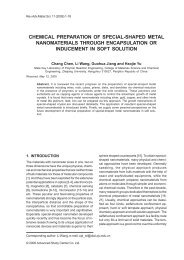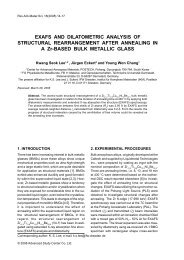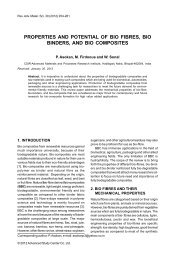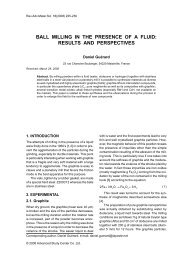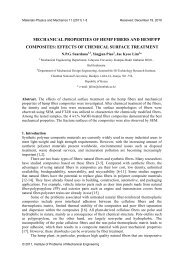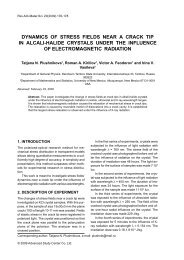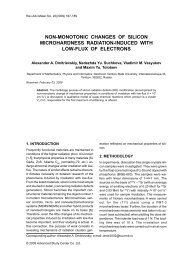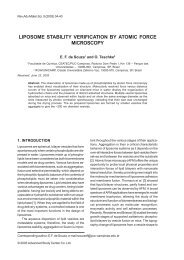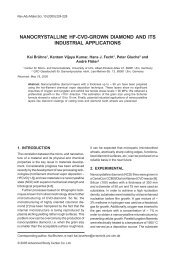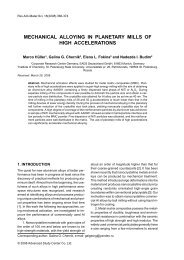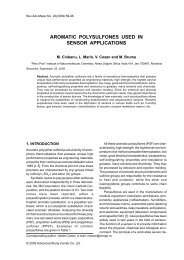surface pretreatment by phosphate conversion coatings – a review
surface pretreatment by phosphate conversion coatings – a review
surface pretreatment by phosphate conversion coatings – a review
Create successful ePaper yourself
Turn your PDF publications into a flip-book with our unique Google optimized e-Paper software.
150 T.S.N. Sankara Narayanan<br />
(Zn 3 (PO 4 ) 2 .4H 2 O), <strong>by</strong> means of X-ray diffraction. According<br />
to Ursini [261, 262] the orientation relationship<br />
(412) phosphophyllite /(111) Fe α role is very<br />
important for epitaxial growth on cold rolled steel<br />
and for an increasing adhesive bond. Laukonis [142]<br />
has studied the role of the oxide films on phosphating<br />
of steel and concluded that it is easier to deposit<br />
zinc <strong>phosphate</strong> <strong>coatings</strong> on ferric oxides than<br />
on ferrous oxides. Hence it is evident that it is not<br />
only the <strong>surface</strong> roughness but also the orientation<br />
and the presence of the oxide film will influence the<br />
phosphating process to a considerable extent.<br />
3.7.1.3. Surface preparation. The cleaning methods<br />
adopted can also influence the phosphating of<br />
steel sheets. It is essential to remove any greasy<br />
contaminants and corrosion products from the <strong>surface</strong><br />
to obtain a good <strong>phosphate</strong> finish. Degreasing<br />
in organic solvents usually promotes the formation<br />
of fine-grained <strong>coatings</strong> while strong alkaline solutions<br />
and pickling in mineral acids yield coarse <strong>coatings</strong>.<br />
Though, the prevention of the excessive metal<br />
attack during pickling is effected <strong>by</strong> potent inhibitors,<br />
it is generally observed that <strong>surface</strong>s that have<br />
been pickled with an effective pickling inhibitor are<br />
difficult to <strong>phosphate</strong> unless a strong alkaline cleaning<br />
operation is employed to remove the inhibitor<br />
residues. Moreover, it is believed that the smut<br />
formed during pickling operation can also influence<br />
the amount and crystal size of the <strong>phosphate</strong> coating<br />
[188]. However, there are reports available, which<br />
are successfully employing potent inhibitors in the<br />
pickling bath, which eliminates the usual detrimental<br />
effects on phosphating. It is claimed that the<br />
inhibitors adsorbed onto the metal <strong>surface</strong> reduces<br />
the amount of hydrogen in the <strong>surface</strong> layer of the<br />
<strong>phosphate</strong>d metal and the <strong>phosphate</strong> coating produced<br />
in such a way are satisfactory for lowering<br />
friction, facilitating cold working and as undercoats<br />
for paint [263].<br />
3.7.1.4. Surface activation. The activating effect<br />
of colloidal titanium <strong>phosphate</strong> was discovered <strong>by</strong><br />
Jernstedt [264] and latter explored <strong>by</strong> several others<br />
[265]. The mechanism of the activation has been<br />
established <strong>by</strong> Tegehall [266]. The colloids in the<br />
aqueous dispersion are disc shaped particles which<br />
have the composition of Na TiO(PO ) . 0-7H2O. These<br />
4 4 2<br />
particles are physically adsorbed on the metal <strong>surface</strong><br />
during the application of colloidal dispersion.<br />
When the activated substrate comes in contact to<br />
a zinc phosphating bath, an ion exchange between<br />
the sodium ions on the <strong>surface</strong> of the titanium <strong>phosphate</strong><br />
particles and the zinc ions of the phosphating<br />
solution takes place [267]. The ion-exchanged<br />
particles act as nucleation agents for the zinc <strong>phosphate</strong><br />
crystals because they have nearly the same<br />
stoichiometry and offer a crystallographic plane for<br />
an epitaxial growth.<br />
The rate of nucleation of the <strong>phosphate</strong> coating<br />
may be markedly increased <strong>by</strong> imposing an additional<br />
activation of the cleaned metal <strong>surface</strong>. A process<br />
for activating steel <strong>surface</strong> prior to phosphating<br />
was patented <strong>by</strong> Yamamato et al. [268] and<br />
Donofrio [269]. Hamilton [270] has proposed a combination<br />
of acid cleaning and a phosphating compound<br />
for <strong>surface</strong> activation, while Hamilton and<br />
Schneider [271] and Morrison and Deilter [272] have<br />
proposed a highly alkaline titanated cleaner prior to<br />
phosphating. Use of 1-2% disodium <strong>phosphate</strong> solution<br />
containing 0.01% of titanium compounds have<br />
been extensively used in industries [273]. Other<br />
compounds like dilute solutions of cupric or nickel<br />
sulphates, oxalic acid and polyphosphonates help<br />
in increasing the number of initial nuclei formed during<br />
phosphating and their subsequent growth, to<br />
yield thin and compact <strong>coatings</strong> of fine-grained nature.<br />
3.7.1.5. Thermal treatments and machining.<br />
Thermal or thermo-chemical treatments cause the<br />
formation of heterogeneous phases, which usually<br />
alter the grain size. Since the initial metal attack<br />
during phosphating occurs mainly at the grain boundaries,<br />
the size of the grains becomes an important<br />
factor in influencing phosphating and dictates the<br />
effect of thermal or thermo-chemical treatments.<br />
Moreover, upon thermal treatment, the distribution<br />
of the constituent elements of heterogeneous alloys<br />
may vary and depending upon which the cathodic<br />
and anodic sites on the <strong>surface</strong> will result<br />
and decides the phosphatability. When studying the<br />
effects of annealing of a 0.3Mn-0.2Ti modified steel<br />
at 280 °C in H 2 -N 2 atmosphere, Usuki et al. [274]<br />
has concluded that such a treatment leads to the<br />
formation of manganese oxide and titanium oxide.<br />
Since the <strong>surface</strong> concentration of manganese is<br />
3-4 times as large as that of titanium, the treatment<br />
enhances the phosphatability of the modified steel<br />
<strong>by</strong> promoting the formation of a predominant proportion<br />
of manganese oxide on the <strong>surface</strong>. Like<br />
wise, Hada et al. [275] have studied the effect of<br />
thermal treatment on the phosphatability of the uncoated<br />
side of one-side painted steel. When heated<br />
for 2 min. at 280 °C, the crystal size and the coating<br />
weight were increased and the ‘P’ ratio was declined<br />
causing an inferior paint adhesion. On the<br />
other hand when heated for a longer period there<br />
results the diffusion of manganese from the bulk to<br />
the <strong>surface</strong> thus improving the phosphatability.



